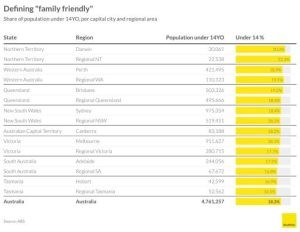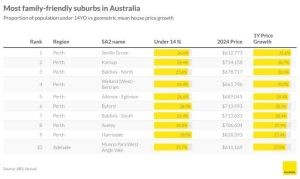The notion of a family friendly suburb is inherently subjective, encompassing a wide array of factors that can vary in importance from one family to another. Traditionally, these factors have included safety, the prevalence of parks and schools, access to family-oriented amenities, community events, proximity to healthcare facilities, low crime rates, and suitable housing options. However, the ideal mix is different for every family and it is therefore subjective. Of course, there are also household budgets to consider
In an attempt to bring objectivity to this subjective concept, we focused on two key metrics: the proportion of the population under 14 years old, using data from the Australian Bureau of Statistics, and house price growth over the past year. This methodology assumes that a high proportion of children indicates a suburb’s appeal to families, while strong house price growth suggests increasing desirability and potential for investment. By combining these factors, we aim to ide
ntify suburbs that are not only attracting families but also experiencing growth in demand – a potential indicator of ongoing development and improvement in family-oriented amenities.

Despite having the smallest overall population among Australia’s regions, regional Northern Territory boasts the highest proportion of young people, with 22.3 per cent of its population under the age of 14. Following closely behind is regional Western Australia, where 19.5 per cent of the population falls into the under-14 category.
When we turn our attention to the capital cities, a similar pattern emerges. Darwin, the capital of the Northern Territory, mirrors its surrounding region by claiming the highest proportion of young people among Australian capitals. However, it’s worth noting that Darwin also has the lowest overall population of any state or territory capital. Brisbane, the capital of Queensland, follows with 19.2 per cent of its population under 14 years old.
At the other end of the spectrum, we find Tasmania. Both its capital city, Hobart, and its regional areas show the lowest proportions of young people in their respective categories. Hobart’s under-14 population stands at 16.9 per cent, while regional Tasmania’s is even lower at 16.5 per cent.
Taking this to the suburb level, we first identified suburbs in the 95th percentile for the population under 14 years old. This meant focusing on areas where at least 25 per cent of residents were children, indicating a strong presence of families. From this subset of family-dense suburbs, we ranked suburbs based on house price growth over the past year. This metric serves as a proxy for increasing desirability and potential for future development.
By combining these factors, the most striking result was the dominance of Perth in the list of top family-friendly suburbs. Perth claimed nine out of the top ten spots, with seven of these located in the south of the city. This reflects not only areas that are popular with families but also the strength of the Perth market right now.
Seville Grove emerges as the most in-demand family friendly suburb with 26.6 per cent of its population aged under 14 years old and a 31.6 per cent house price growth over the last year. Despite this growth, it remains relatively affordable, with an average house price of $612,773 – the second lowest among the top-ranked suburbs. Not far behind is Karnup, another Perth suburb, boasting similar demographics but with a higher price point.
Interestingly, the only non-Perth suburb to make the top of the list was Munno Para West–Angle Vale in the north of Adelaide. With 25.7 per cent of its population under 14 and a 27 per cent price growth over the last year, it is also the most affordable suburb on the list.
The same methodology was used to identify the three most family-friendly suburbs for each capital city and regional area across Australia. However, adjustments to the under-14 population threshold were necessary for several regions where the proportion of young residents was lower than the national standard.
In regional New South Wales, we lowered the bar slightly, considering suburbs family-friendly if at least 22.6 per cent of the population was under 14. For regional Victoria, the threshold was set at 22.2 per cent. Adelaide’s family-friendly suburbs were those with at least 21.5 per cent of residents under 14, while in regional South Australia, the figure was 19.9 per cent.
Tasmania presented the lowest thresholds – in Hobart, suburbs with 20.6 per cent or more of the population under 14 were included, while in regional Tasmania, the cut-off was 19.9 per cent.

